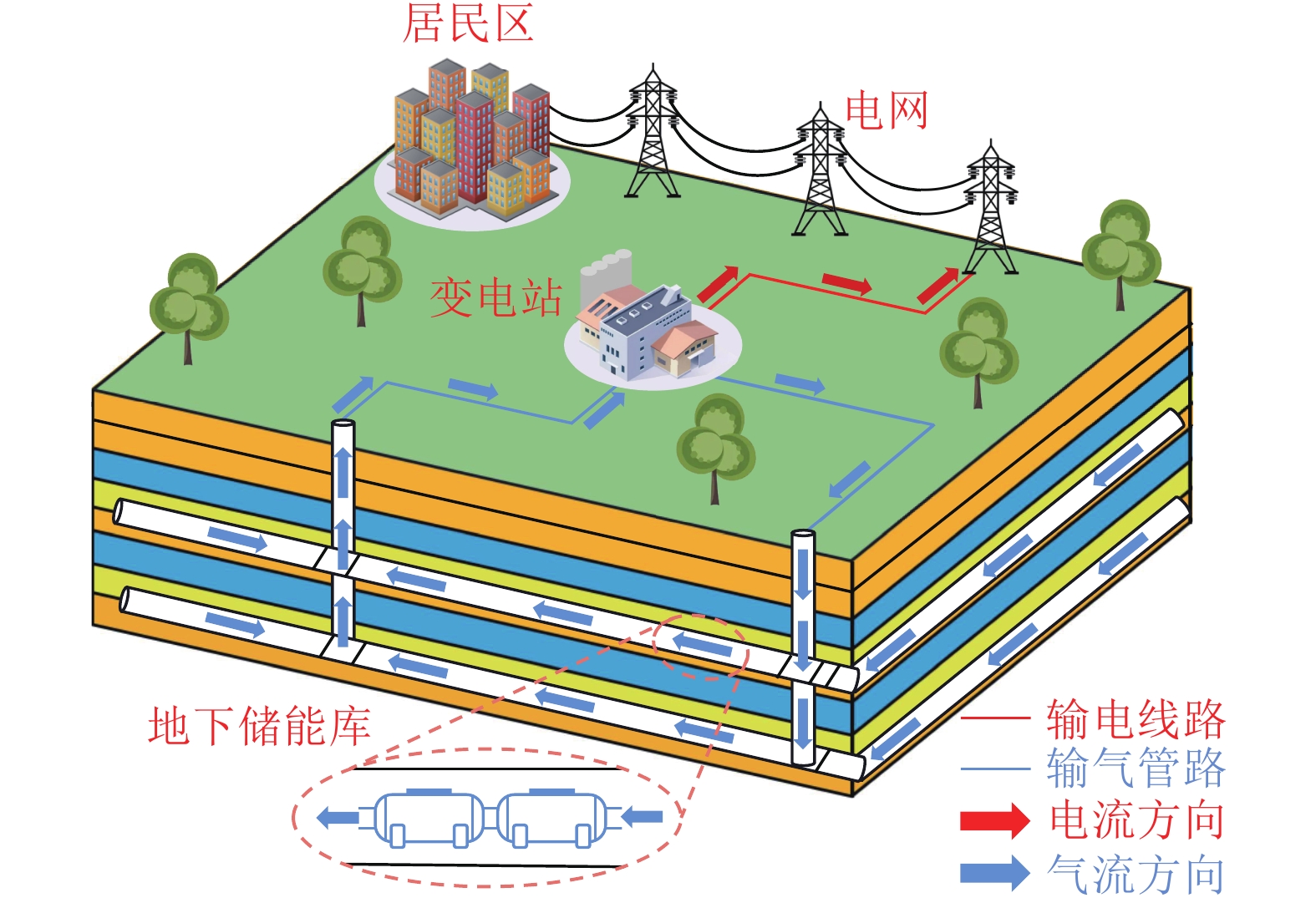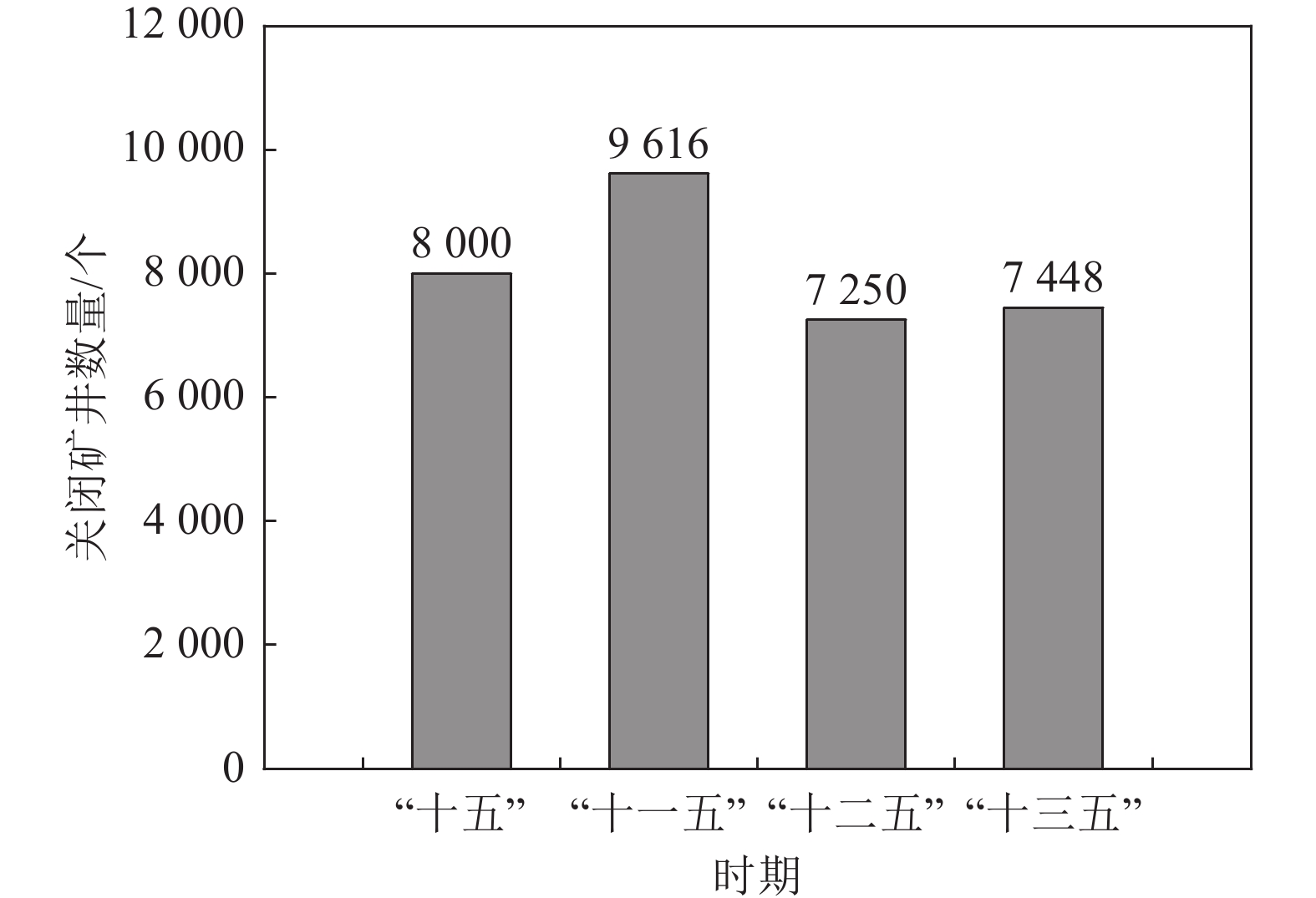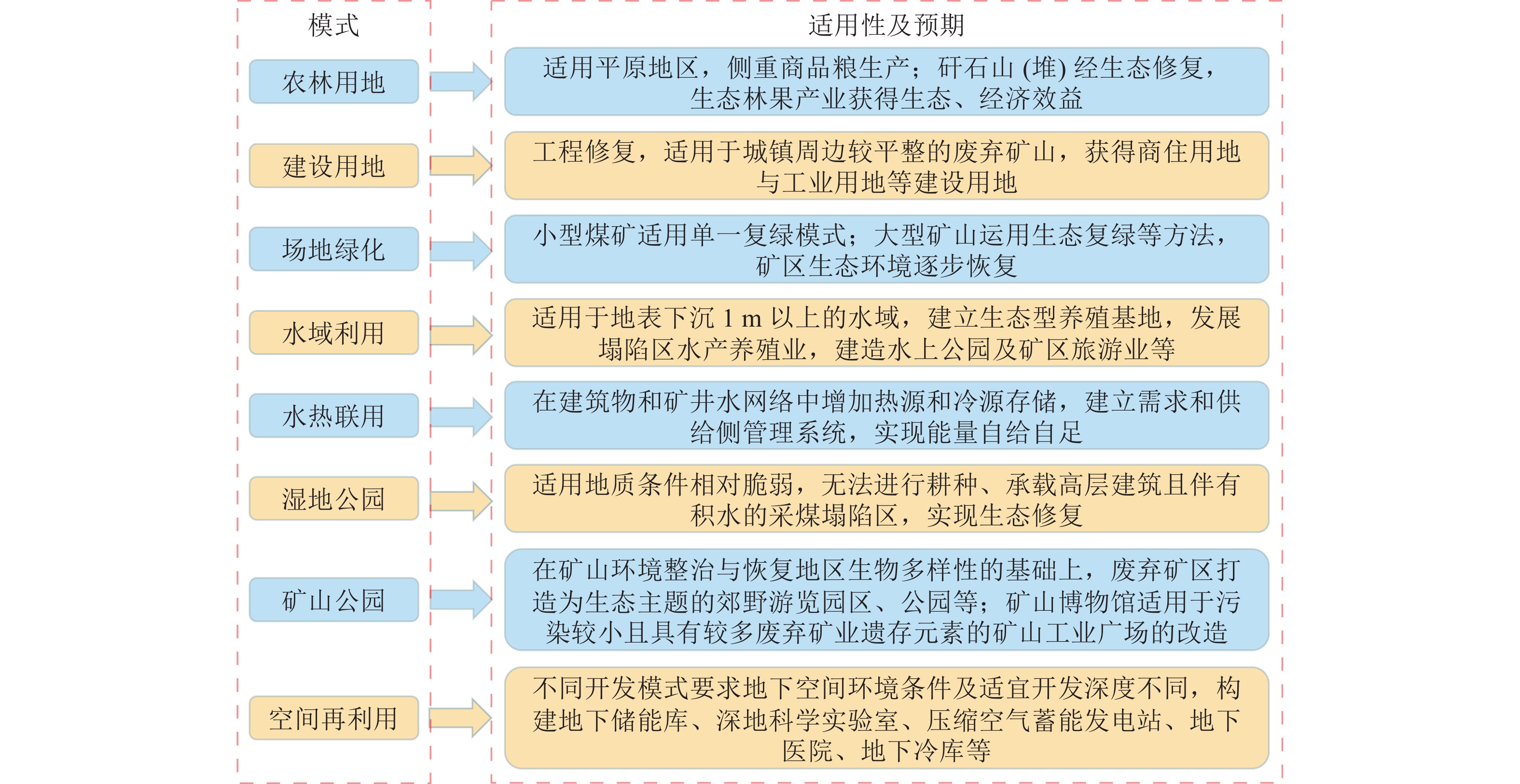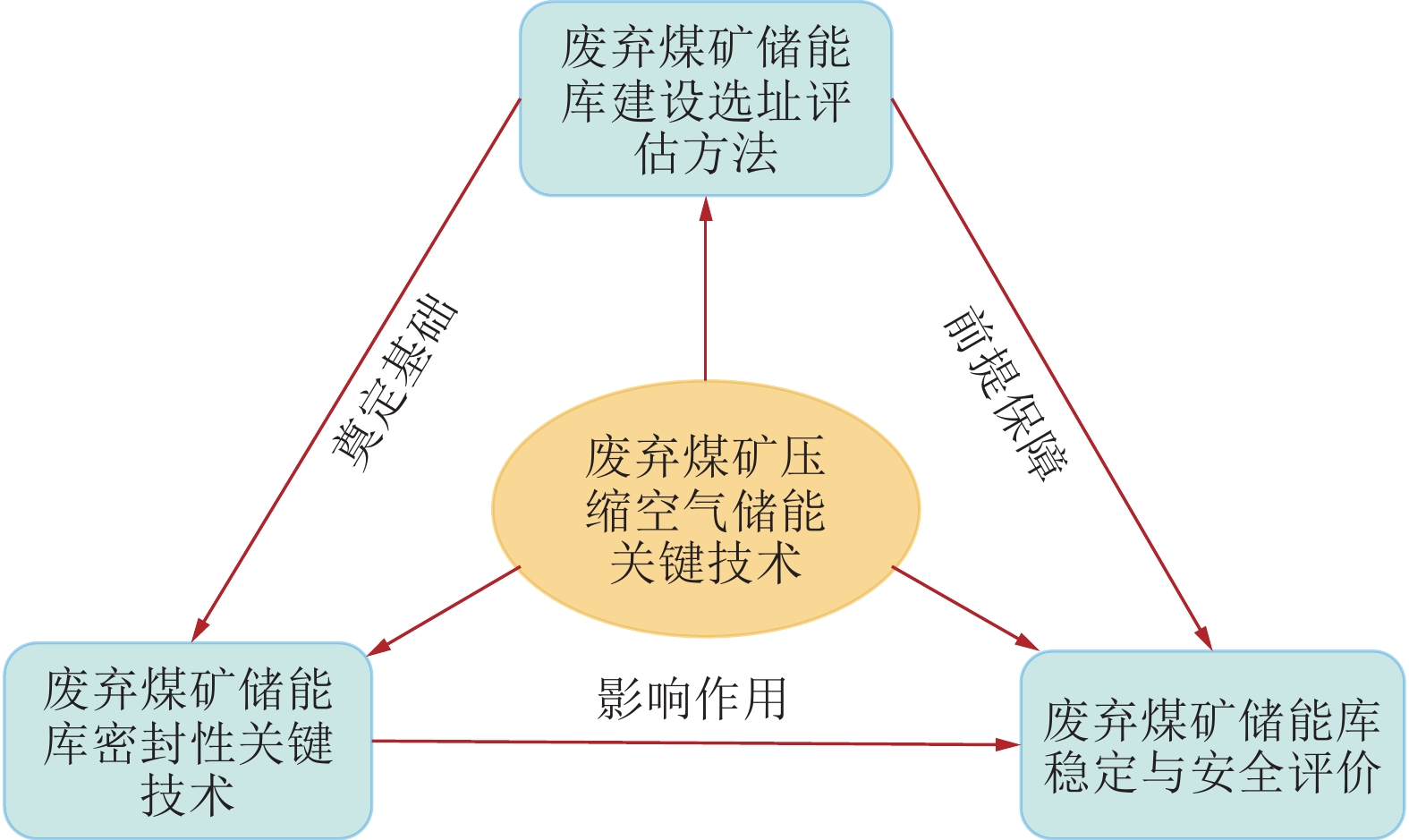Research status and development trend of compressed air energy storage in abandoned coal mines
-
摘要:
压缩空气储能具有建设成本低、设备占地面积小、储能周期长以及环保等优点,探索地下空间压缩空气储能技术发展是实现我国“双碳”目标的创新途径之一,地下空间储能库可分为盐穴、含水层、枯竭油气田、废弃煤矿及岩洞储能库。随着国内废弃煤矿数量逐年增多,直接将资源枯竭的煤矿关闭不仅造成巨大的地下空间资源浪费,还极有可能诱发一系列的安全、环境等问题,利用废弃煤矿地下空间作为压缩空气储能电站储能库具有很好的应用前景。基于此,系统梳理了我国废弃煤矿地下空间资源利用情况,阐述了废弃煤矿地下储能库建设、地下储能库密封性和稳定性的研究现状,着重介绍了废弃煤矿地下空间压缩空气储能的研究进展与存在问题。分析表明:①废弃煤矿有大量可利用空间,总结了废弃煤矿地下空间的8种再利用模式:农林用地、建设用地、场地绿化、水域利用、水热联用、湿地公园、矿山公园、空间再利用;②我国废弃煤矿压缩空气储能的研究起步晚,基础理论研究薄弱,关键技术不成熟,且煤矿地质条件复杂,相关应用基础研究不足,尚未实现商业化、规模化推广应用;③总结提出了应对废弃煤矿压缩空气储能的三项关键技术,即废弃煤矿储能库建设选址评估方法、废弃煤矿储能库密封性关键技术、废弃煤矿储能库稳定性与安全评价;建立了废弃煤矿压缩空气储能库建设选址流程图。
Abstract:Compressed air energy storage (CAES) has the advantages of low construction cost, small equipment footprint, long storage cycle and environmental protection. Exploring the development of CAES technology in underground space is one of the innovative approaches to achieve China’s “dual-carbon” goal. Underground energy storage reservoirs can be classified into salt caverns, aquifers, depleted oil and gas fields, abandoned coal mines, and caverns. With the increasing number of abandoned coal mines in China, the direct closure of resource-depleted coal mines not only cause a significant waste of underground space resources, but also induce a series of safety, environmental and other issues. Therefore, utilizing the underground space of abandoned coal mines as CAES reservoirs holds great application prospects. The analysis shows that, ① There is a large amount of usable space in abandoned coal mines, and eight reuse modes of underground space in abandoned coal mines have been summarized: agricultural and forestry land, construction land, site greening, watershed utilization, water-heat combination, wetland park, mine park, and space reuse. ② The research on CAES in abandoned coal mines in China started late, the basic theoretical research is weak, the key technologies is immature, and geological conditions in coal mines are complex, the relevant applications of basic research is insufficient, and the commercialization, large-scale promotion and application have not yet been achieved. ③ Three key technologies are summarized and proposed to cope with the CAES in abandoned coal mines, i.e., the evaluation method of site selection for the construction of abandoned coal mine energy storage reservoirs, the key technology for the sealing of abandoned coal mine energy storage reservoirs, and the stability and safety evaluation of abandoned coal mine energy storage reservoirs. A flowchart for siting the construction of CAES reservoirs in abandoned coal mines has been established.
-
-
表 1 各类储能技术特点
Table 1 Characteristics of various energy storage technologies
储能技术类型 效率/% 寿命/a 容量等级 优点 缺点 机械储能 抽水蓄能 70~75 40~60 数百兆瓦时 寿命长,高效率,低成本 建设时间长,难选址,启动慢 压缩空气储能 50~70 30~40 数百兆瓦时 环保,低成本,大容量,用地少 大型储能库选址困难 锂离子电池 85~98 5~10 数十兆瓦时 能量密度大,自放电小 高成本、有风险 电化学储能 全钒液流电池 75~85 5~15 数十兆瓦时 安全性好 能量密度小 钠硫电池 75~90 10~15 数十兆瓦时 响应快 运行温度高,有风险 铅碳电池 70~90 3~8 百兆瓦时 高性价比、技术成熟 寿命短、存在污染 表 2 重点产煤省份矿井大巷空间估算
Table 2 Estimation of mine roadway space in key coal-producing provinces
省份 产量9万~30万t/a 产量45万~90万t/a 产量120万~240万t/a 产量300万~900万t/a 产量≥1000万t/a 煤矿数量/个 空间/104 m3 煤矿数量/个 空间/104 m3 煤矿数量/个 空间/104 m3 煤矿数量/个 空间/104 m3 煤矿数量/个 空间/104 m3 山西 18 17.6 518 1936.3 291 2030.0 81 864.4 10 164.0 内蒙古 13 12.7 183 684.1 150 1046.4 63 672.3 16 262.4 陕西 41 40.0 105 392.5 47 327.8 26 277.5 11 180.4 河北 29 28.3 16 59.8 16 111.6 8 85.4 0 0 安徽 0 0 6 22.4 23 160.4 16 170.8 1 16.4 山东 17 16.6 58 216.8 22 153.5 13 138.7 0 0 江苏 0 0 2 7.5 5 34.9 1 10.7 0 0 河南 123 120.0 70 261.7 40 279.0 8 85.4 0 0 四川 253 246.7 30 112.1 6 41.9 0 0 0 0 贵州 319 311.3 129 482.2 19 132.5 0 0 0 0 宁夏 6 5.9 15 56.1 6 41.9 18 192.1 1 16.4 甘肃 22 21.5 12 44.9 14 97.7 5 53.4 0 0 云南 243 237.2 21 78.5 1 7.0 2 21.3 0 0 辽宁 4 3.9 8 29.9 14 97.7 3 32.0 0 0 吉林 23 22.4 8 29.9 4 27.9 1 10.7 0 0 黑龙江 189 184.4 14 52.3 22 153.5 6 64.0 0 0 新疆 8 7.8 67 250.4 11 76.7 11 117.4 2 32.8 总计/104m3 1308 1277.6 1262 4717.4 691 4820.4 262 2796.1 41 672.3 表 3 重点产煤省份矿井井筒空间估算
Table 3 Estimation of shaft space in key coal-producing provinces
区域分布 空间/104 m3 产量9万~30万t/a 产量45万~90万t/a 产量120万~240万t/a 产量300万~900万t/a 产量≥1000万t/a 西北部地区 内蒙古 7.8 153.7 144.0 90.7 25.9 陕西 24.6 88.2 45.1 37.4 17.8 宁夏 3.6 12.6 5.8 25.9 1.6 甘肃 13.2 10.1 13.4 7.2 0 新疆 4.8 50.4 10.6 15.8 3.2 山西 28.8 1160.3 745.0 311.0 43.2 河北 46.4 35.8 40.9 30.7 0 安徽 0 13.4 58.9 61.4 0 中东部地区 山东 27.2 129.9 56.3 49.9 0 江苏 0 4.5 12.8 3.8 0 河南 196.8 1568.0 102.4 30.7 0 辽宁 6.4 17.9 35.8 11.5 0 吉林 36.8 17.9 10.2 3.8 0 黑龙江 302.4 31.4 56.3 23.0 0 西南地区 四川 253.0 42.0 9.6 0 0 贵州 319.0 180.6 30.4 0 0 云南 243.0 29.4 1.6 4.8 0 井筒空间总计 1513.8 2135.0 1379.2 708.0 96.1 表 4 2座传统压缩空气储能电站运行技术参数对比
Table 4 Comparison of technical parameters of operating CAES plants
参数 Huntorf电站 McIntosh电站 压缩机组性能 循环效率/% 42 54 最大输入功率/MW 60 50 最大空气流速/(kg·s−1) 108 约90 注气时间/h 约8 约38 储气腔体 腔体压力范围/MPa 4.3~7.0 5.1~7.9 腔体深度/m 650~800 457~720 腔体总体积/m3 31×104 约54×104 膨胀机组性能 最大输出功率/MW 321 110 最小输出功率/MW 100 10 满负荷运行时间/h 约2 约24 最大空气流速/(kg·s−1) 455 154 -
[1] 谢和平,高明忠,高 峰,等. 关停矿井转型升级战略构想与关键技术[J]. 煤炭学报,2017,42(6):1355−1365. XIE Heping,GAO Mingzhong,GAO Feng,et al. Strategic conceptualization and key technology for the transformation and upgrading of shut-down coal mines[J]. Journal of China Coal Society,2017,42(6):1355−1365.
[2] 刘 峰,李树志. 我国转型煤矿井下空间资源开发利用新方向探讨[J]. 煤炭学报,2017,42(9):2205−2213. LIU Feng,LI Shuzhi. Discussion on the new development and utilization of underground space resources of transitional coal mines[J]. Journal of China Coal Society,2017,42(9):2205−2213.
[3] 袁 亮,杨 科. 再论废弃矿井利用面临的科学问题与对策[J]. 煤炭学报,2021,46(1):16−24. YUAN Liang,YANG Ke. Further discussion on the scientific problems and countermeasures in the utilization of abandoned mines[J]. Journal of China Coal Society,2021,46(1):16−24.
[4] 何秋德,陈 宁,罗萍嘉. 基于压缩空气蓄能技术的煤矿废弃巷道再利用研究[J]. 矿业研究与开发,2013,33(4):37−39, 65. HE Qiude,CHEN Ning,LUO Pingjia. Research on reuse of abandoned roadway in coal mine based on the compressed air energy storage technology[J]. Mining Research and Development,2013,33(4):37−39, 65.
[5] 夏才初,张平阳,周舒威,等. 大规模压气储能洞室稳定性和洞周应变分析[J]. 岩土力学,2014,35(5):1391−1398. XIA Caichu,ZHANG Pingyang,ZHOU Shuwei,et al. Stability and tangential strain analysis of large-scale compressed air energy storage cavern[J]. Rock and Soil Mechanics,2014,35(5):1391−1398.
[6] 王双明,刘 浪,赵玉娇,等. “双碳”目标下赋煤区新能源开发−未来煤矿转型升级新路径[J]. 煤炭科学技术,2023,51(1):59−79. doi: 10.13199/j.cnki.cst.2022-2169 WANG Shuangming,LIU Lang,ZHAO Yujiao,et al. New energy exploitation in coal-endowed areas under the target of “double carbon”: a new path for transformation and upgrading of coal mines in the future[J]. Coal Science and Technology,2023,51(1):59−79. doi: 10.13199/j.cnki.cst.2022-2169
[7] 杨春和,梁卫国,魏东吼,等. 中国盐岩能源地下储存可行性研究[J]. 岩石力学与工程学报,2005,24(24):4409−4417. YANG Chunhe,LIANG Weiguo,WEI Donghou,et al. Investigation on possibility of energy storage in salt rock in China[J]. Chinese Journal of Rock Mechanics and Engineering,2005,24(24):4409−4417.
[8] 王 帅,蒲宝基,蹇军强,等. 废弃煤矿压缩空气储能地质安全稳定性分析[J]. 煤炭工程,2020,52(8):133−137. WANG Shuai,PU Baoji,JIAN Junqiang,et al. Geological safety and stability analysis on compressed air energy storage of abandoned coal mine[J]. Coal Engineering,2020,52(8):133−137.
[9] 郭朝斌,王志辉,刘 凯,等. 特殊地下空间应用与研究现状[J]. 中国地质,2019,46(3):482−492. GUO Chaobin,WANG Zhihui,LIU Kai,et al. The application and research progress of special underground space[J]. Geology in China,2019,46(3):482−492.
[10] BROWN LW. Abandoned coal mine stores gas for Colorado peak-day demands[J]. Pipeline Industry,1978,49(3):1−10.
[11] 常春勤,邹友峰. 国内外废弃矿井资源化开发模式述评[J]. 资源开发与市场,2014,30(4):425−429. CHANG Chunqin,ZOU Youfeng. Review on resource development mode of abandoned underground space of Mine[J]. resource development and market,2014,30(4):425−429.
[12] 杨春和,王同涛. 深地储能研究进展[J]. 岩石力学与工程学报,2022,41(9):1729−1759. YANG Chunhe,WANG Tongtao. Advance in deep underground energy storage[J]. Chinese Journal of Rock Mechanics and Engineering,2022,41(9):1729−1759.
[13] 陈 涛,施锡林,李金龙,等. 盐穴储气库水平井造腔模拟试验[J]. 油气储运,2019,38(11):1257−1264. CHEN Tao,SHI Xilin,LI Jinlong,et al. Simulation test on the horizontal-well leaching of salt-cavern gas storage[J]. Transportation and Storage,2019,38(11):1257−1264.
[14] 陈祥胜,李银平,施锡林,等. 地下盐穴储气库泄漏原因及防治措施研究[J]. 岩土力学,2019,40(S1):367−373, 389. CHEN Xiangsheng,LI Yinping,SHI Xilin,et al. Analysis of leakage risks and prevention measures of underground salt cavern gas storage[J]. Rock and Soil Mechanics,2019,40(S1):367−373, 389.
[15] 周舒威,夏才初,张平阳,等. 地下压气储能圆形内衬洞室内压和温度引起应力计算[J]. 岩土工程学报,2014,36(11):2025−2035. ZHOU Shuwei,XIA Caichu,ZHANG Pingyang,et al. Analytical approach for stress induced by internal pressure and temperature of underground compressed air energy storage in a circular lined rock cavern[J]. Chinese Journal of Geotechnical Engineering,2014,36(11):2025−2035.
[16] CHEN X H,WANG J G. Stability analysis for compressed air energy storage cavern with initial excavation damage zone in an abandoned mining tunnel[J]. Journal of Energy Storage,2022,45:103725. doi: 10.1016/j.est.2021.103725
[17] 马洪岭,梁孝鹏,赵 凯,等. 山东泰安盐穴储气库地质可行性分析[J]. 隧道与地下工程灾害防治,2022,4(2):19−27. MA Hongling,LIANG Xiaopeng,ZHAO Kai,et al. Geological feasibility analysis of Tai’an salt cavern gas storage in Shandong Province[J]. Hazard Control in Tunnelling and Underground Engineering,2022,4(2):19−27.
[18] 彭振华,李俊彦,杨 森,等. 利用废弃石膏矿储存原油可行性分析[J]. 工程地质学报,2013,21(3):470−475. PENG Zhenhua,LI Junyan,YANG Sen,et al. Feasibility analysis of utilization of waste gypsum mine for crude oil storage[J]. Journal of Engineering Geology,2013,21(3):470−475.
[19] 吴皓文,王 军,龚迎莉,等. 储能技术发展现状及应用前景分析[J]. 电力学报,2021,36(5):434−443. WU Haowen,WANG Jun,GONG Yingli,et al. Development status and application prospect analysis of energy storage technology[J]. Jouranl of Electric Power,2021,36(5):434−443.
[20] 梁丽君,何军飞. 压缩空气储能技术及其标准现状分析[J]. 机电工程技术,2020,49(8):36−37. LIANG Lijun,HE Junfei. Analysis of compressed air energy storage technology and its standards status[J]. Mechanical and Electrical Engineering Technology,2020,49(8):36−37.
[21] 陈海生,刘金超,郭 欢,等. 压缩空气储能技术原理[J]. 储能科学与技术,2013,2(2):146−151. CHEN Haisheng,LIU Jinchao,GUO Huan,et al. Technical principle of compressed air energy storage system[J]. Energy Storage Science and Technology,2013,2(2):146−151.
[22] 董 舟,李 凯,王永生,等. 压缩空气储能技术研究及应用现状[J]. 河北电力技术,2019,38(5):18−20. DONG Zhou,LI Kai,WANG Yongsheng,et al. Research and application status of compressed air energy storage technology[J]. Hebei Electric Power,2019,38(5):18−20.
[23] 郭新生,傅秦生,赵知辛,等. 电热冷联产的新压缩空气蓄能系统[J]. 热能动力工程,2005,20(2):170−173. GUO Xinsheng,FU Qinsheng,ZHAO Zhixin,et al. Anew type of compressed air energy-storage system for the cogeneration of electricity, heat and cooling energy[J]. Journal of Engineering for Theramal Energy and Power,2005,20(2):170−173.
[24] FAN J,LIU W,JIANG D,et al. Thermodynamic and applicability analysis of a hybrid CAES system using abandoned coal mine in China[J]. Energy,2018,157:31−44. doi: 10.1016/j.energy.2018.05.107
[25] 纪 律,陈海生,张新敬,等. 压缩空气储能技术研发现状及应用前景[J]. 高科技与产业化,2018(4):52−58. JI LYU,CHEN Haisheng,ZHANG Xinjing,et al. Research and development status and application prospect of compressed air energy storage technology[J]. High Technology and Industrialization,2018(4):52−58.
[26] CHEN J,LIU W,JIANG D,et al. Preliminary investigation on the feasibility of a clean CAES system coupled with wind and solar energy in China[J]. Energy,2017,127:462−478. doi: 10.1016/j.energy.2017.03.088
[27] LI Y, LI Y, LIU Y, et al. Compressed air energy storage in aquifers: basic principles, considerable factors, and improvement approaches[J]. Reviews in Chemical Engineering. 2019, 37(5): 561−584.
[28] 郭朝斌,李 采,杨利超,等. 压缩空气地质储能研究现状及工程案例分析[J]. 中国地质调查,2021,8(4):109−119. GUO Chaobin,LI Cai,YANG Lichao,et al. Research review and engineering case analysis of geological compressed air energy storage[J]. Geological Survey of China,2021,8(4):109−119.
[29] 王国法,任世华,庞义辉,等. 煤炭工业“十三五”发展成效与“双碳”目标实施路径[J]. 煤炭科学技术,2021,49(9):1−8. WANG Guofa,REN Shihua,PANG Yihui,et al. development achievements of china’s coal industry during the 13 th five-year plan period and implementation path of “dual carbon” target[J]. Coal Science and Technology,2021,49(9):1−8.
[30] 王 兵,刘朋帅,邓凯磊,等. 二次矿山管理的科学内涵与构想[J]. 煤炭经济研究,2020,40(12):51−58. WANG Bing,LIU Pengshuai,DENG Kailei,et al. The scientific connotation and conception of secondary mine management[J]. Coal Economic Research,2020,40(12):51−58.
[31] 谢友泉,高 辉,苏志国,等. 废弃矿井地热资源的开发利用[J]. 太阳能,2020(10):13−18. XIE Youquan,GAO Hui,SU Zhiguo,et al. Development and utili ation of geothermal resources in abandoned mines[J]. Solar Energy,2020(10):13−18.
[32] 谢友泉,高 辉,苏志国,等. 废弃矿井资源的可再生能源开发利用[J]. 可再生能源,2020,38(3):423−426. XIE Youquan,GAO Hui,SU Zhigao,et al. Exploitation and utilization of renewable energy from waste mine resources[J]. Renewable Energy Resources,2020,38(3):423−426.
[33] 袁 亮. 我国煤炭资源高效回收及节能战略研究[J]. 中国矿业大学学报(社会科学版),2018,20(1):3−12. YUAN Liang. Strategies of high efficiency recovery and energy saving for coal resources in China[J]. Journal of China University of Mining and Technology(Social Sciences),2018,20(1):3−12.
[34] 袁 亮,姜耀东,王 凯,等. 我国关闭/废弃矿井资源精准开发利用的科学思考[J]. 煤炭学报,2018,43(1):14−20. YUAN Liang,JIANG Yaodong,WANG Kai,et al. Precision exploitation and utilization of closed/abandoned mine resources in China[J]. Journal of China Coal Society,2018,43(1):14−20.
[35] 戴家生,夏明强,潘 磊,等. 典型废弃矿井综合治理分析[J]. 煤炭技术,2020,39(6):97−99. DAI Jiasheng,XIA Mingqiang,PAN Lei,et al. Analysis of comprehensive treatment of typical abandoned mines[J]. Coal Technology,2020,39(6):97−99.
[36] 霍 冉,徐向阳,姜耀东. 国外废弃矿井可再生能源开发利用现状及展望[J]. 煤炭科学技术,2019,47(10):267−273. HUO Ran,XU Xiangyang,JIANG Yaodong,et al. Status and prospect on development and utilization of renewable energy in abandoned mines abroad[J]. Coal Science and Technology,2019,47(10):267−273.
[37] CHRISTIAN Melchers,PETER Goerke-Mallet,LAURA Henkel,et al. Experiences with mine closure in the European coal mining industry: Suggestions for reducing closure risks[J]. Mining Report,2016,52(3):212−220.
[38] ILG P,GABBERT S,WEIKARD H P. Nuclear waste man-agement under approaching disaster: a comparison of decom-missioning strategies for the German repository Asse Ⅱ[J]. Risk Analysis,2017,37(7):1213. doi: 10.1111/risa.12648
[39] ROSINA E,SANSONETTI A,EEBA S. Focus on soluble salts transport phenomena: the study cases of Leonardo mural paintings at Sala delle Asse(Milan)[J]. Construction & Building Materials,2016,136:643−652.
[40] 桑逢云,刘文革,韩甲业,等. 英国废弃煤矿瓦斯开发成功经验及对我国的启示[J]. 中国煤层气,2019,16(2):3−5. SANG Fengyun,LIU Wenge,HAN Jiaye,et al. Enlightenment of China on successful experiences of abandoned mine methane development in britain[J]. China Coalbed Methane,2019,16(2):3−5.
[41] 武 强,刘宏磊,陈 奇,等. 矿山环境修复治理模式理论与实践[J]. 煤炭学报,2017,42(5):1085−1092. WU Qiang,LIU Honglei,CHEN Qi,et al. Theoretical study of mine geo-environmental restoration model and its application[J]. Journal of China Coal Society,2017,42(5):1085−1092.
[42] 顾大钊. 煤矿地下水库理论框架和技术体系[J]. 煤炭学报,2015,40(2):239−246. GU Dazhao. Theory framework and technological system of coal mine underground reservoir[J]. Journal of China Coal Society,2015,40(2):239−246.
[43] 陈苏社,黄庆享,薛 刚,等. 大柳塔煤矿地下水库建设与水资源利用技术[J]. 煤炭科学技术,2016,44(8):21−28. CHEN Sushe,HUANG Qingxiang,XUE Gang,et al. Technology of underground reservoir construction and water resource utilization in Daliuta Coal Mine[J]. Coal Science and Technology,2016,44(8):21−28.
[44] 谢和平,高明忠,刘见中,等. 煤矿地下空间容量估算及开发利用研究[J]. 煤炭学报,2018,43(6):1487−1503. XIE Heping,GAO Mingzhong,LIU Jianzhong,et al. Research on exploitation and volume estimation of underground space in coal mines[J]. Journal of China Coal Society,2018,43(6):1487−1503.
[45] 史箫笛,康小兵,罗向奎,等. 闭坑煤矿井下空间资源开发利用评价[J]. 煤炭科学技术,2020,48(3):112−119. SHI Xiaodi,KANG Xiaobing,LUO Xiangkui,et al. Development and utilization evaluation of underground space resources in closed pit coal mine[J]. Coal Science and Technology,2020,48(3):112−119.
[46] 刘钦节,王金江,杨 科,等. 关闭/废弃矿井地下空间资源精准开发利用模式研究[J]. 煤田地质与勘探,2021,49(4):71−78. LIU Qinjie,WANG Jinjiang,YANG Ke,et al. Research on the model of accurate exploitation and utilization of underground space resources in closed/abandoned mines[J]. Coal Geology and Exploration,2021,49(4):71−78.
[47] 任 辉,吴国强,张谷春,等. 我国关闭/废弃矿井资源综合利用形势分析与对策研究[J]. 中国煤炭地质,2019,31(2):1−6. REN Hui,WU Guoqiang,ZHANG Guchun,et al. The situation analysis and strategy research of closed/abandoned mine resources comprehensive utilization in China[J]. Coal Geology China,2019,31(2):1−6.
[48] 王 争,李国富,周显俊,等. 山西省废弃矿井煤层气地面钻井开发关键问题与对策[J]. 煤田地质与勘探,2021,49(4):86−95. WANG Zheng,LI Guofu,ZHOU Xianjun,et al. Key problems and countermeasures of CBM development through surface boreholes in abandoned coal mines of Shanxi Province[J]. Coal Geology & Exploration,2021,49(4):86−95.
[49] 杜俊生,陈 结,姜德义,等. 中国废弃煤矿压气蓄能潜力与初步可行性研究[J]. 工程科学与技术,2023,55(1):253−264. DU Junsheng,CHEN Jie,JIANG Deyi,et al. Study on the potential and pre-feasibility of compressed air energy storage of abandoned coal mines in China[J]. Advanced Engineering Sciences,2023,55(1):253−264.
[50] 雷明星,梅灿旗,王 楠. 关闭矿井地下空间资源开发利用思考与建议[J]. 煤炭经济研究,2021,41(2):41−45. LEI Mingxing,MEI Canqi,WANG Nan. Thoughts and suggestions on development and utilization of underground space resources in closed mine[J]. Coal Economic Research,2021,41(2):41−45.
[51] 李宝山, 肖明松, 周志学, 等. 针对废弃矿井的可再生能源综合开发利用[J]. 太阳能, 2019(5): 13-16. LI Baoshan, XIAO Mingsong, ZHOU Zhixue, et al Comprehensive development and utilization of renewable energy for abandoned mines [J] Solar Energy, 2019 (5): 13-16
[52] ISHIHATA T. Underground compressed air storage facility for CAES-GT power plant utilizing an airtight lining[J]. International Society of Rock Engineering,1997,5(1):17−21.
[53] GUO C B,PAN L H,ZHANG K N,et al. Comparison of compressed air energy storage process in aquifers and caverns based on the Huntorf CAES plant[J]. Applied Energy,2016,181:342−356. doi: 10.1016/j.apenergy.2016.08.105
[54] 牛文进,王 璐,柳研青. 基于废弃矿井的空气压缩蓄能电站应用研究[J]. 科技风,2019(22):186. NIU Wenjin,WANG Lu,LIU Yanqing. Research on application of air compression storage power station based on abandoned mine[J]. Science and Technology,2019(22):186.
[55] 刘汉斌,张亚宁,程芳琴. 山西关闭煤矿资源利用现状及开发利用建议[J]. 煤炭经济研究,2019,39(10):78−82. doi: 10.13202/j.cnki.cer.20191030.001 LIU Hanbin,ZHANG Yaning,CHENG Fangqin. Utilization status and development suggestions on closed coal mine resources in Shanxi Province[J]. Coal Economic Research,2019,39(10):78−82. doi: 10.13202/j.cnki.cer.20191030.001
[56] ALLEN R D, DOHERTY T J, KANNBERG L D. Summary of selected compressed air energy storage studies[R]. Pacific Northwest Laboratory, Spingfield, 1985.
[57] ISHIHATA T. Underground compressed air storage facility for CAES-G/T power plant utilizing an airtight lining[J]. International Journal of Rock Mechanics and Mining Sciences,1997,5(1):17−21.
[58] 叶 斌,程子睿,彭益成. 压气储能洞室气密性影响因素分析[J]. 同济大学学报(自然科学版),2016,44(10):1526−1532. doi: 10.11908/j.issn.0253-374x.2016.10.008 YE Bin,CHENG Zirui,PENG Yicheng. Analysis of influence factors on air tightness of underground cavern for compressed air energy storage[J]. Journal of Tongji University(Natural Science),2016,44(10):1526−1532. doi: 10.11908/j.issn.0253-374x.2016.10.008
[59] 周 瑜,夏才初,赵海斌,等. 压气储能内衬洞室的空气泄漏率及围岩力学响应估算方法[J]. 岩石力学与工程学报,2017,36(2):297−309. ZHOU Yu,XIA Caichu,ZHAO Haibin,et al. A method for estimating air leakage through inner seals and mechanical responses of the surrounding rock of lined rock caverns for compressed air energy storage[J]. Chinese Journal of Rock Mechanics and Engineering,2017,36(2):297−309.
[60] ZHOU Y,XIA C,ZHAO H,et al. An iterative method for evaluating air leakage from unlined compressed air energy storage (CAES) caverns[J]. Renewable Energy,2018,120:434−445. doi: 10.1016/j.renene.2017.12.091
[61] 夏才初,徐英俊,王辰霖,等. 基于非稳态渗流过程的压气储能洞室空气渗漏率计算[J]. 岩土力学,2021,42(7):1765−1773. doi: 10.16285/j.rsm.2020.1385 XIA Caichu,XU Yingjun,WANG Chenlin,et al. Calculation of air leakage rate in lined cavern for compressed air energy storage based on unsteady seepage process[J]. Rock and Soil Mechanics,2021,42(7):1765−1773. doi: 10.16285/j.rsm.2020.1385
[62] GEORGE S,THOMAS S. Transport phenomena through polymeric systems[J]. Progress in Polymer Science,2001,26(6):985−1017. doi: 10.1016/S0079-6700(00)00036-8
[63] WU D,WANG J,HU B,et al. A coupled thermo-hydro-mechanical model for evaluating air leakage from an unlined compressed air energy storage cavern[J]. Renewable Energy,2020,146:907−920. doi: 10.1016/j.renene.2019.07.034
[64] KIM H M,RUTQVIST J,RYU D W,et al. Exploring the concept of compressed air energy storage (CAES) in lined rock caverns at shallow depth: a modeling study of air tightness and energy balance[J]. Applied Energy,2012,92:653−667. doi: 10.1016/j.apenergy.2011.07.013
[65] RUTQVIST J,KIM H M,RYU D W,et al. Modeling of coupled thermodynamic and geomechanical performance of underground compressed air energy storage in lined rock caverns[J]. International Journal of Rock Mechanics and Mining Sciences,2012,52:71−81. doi: 10.1016/j.ijrmms.2012.02.010
[66] LI X,ZUO Y,ZHUANG X,et al. Estimation of fracture trace length distributions using probability weighted moments and L-moments[J]. Engineering Geology,2014,168(2):69−85.
[67] NAKAGAWA K,KOMADA H,MIYASHITA K,et al. Prevention of leakage of compressed air stored in unlined rock caverns[J]. Doboku Gakkai Ronbunshu,1986,370:233−241.
[68] ZHOU S,ZHOU S,XIA C,et al. An analytical solution for mechanical responses induced by temperature and air pressure in a lined rock cavern for underground compressed air energy storage[J]. Rock Mechanics and Rock Engineering,2015,48(2):749−770. doi: 10.1007/s00603-014-0570-4
[69] KIM H M,PARK D,RYU D W,et al. Parametric sensitivity analysis of ground uplift above pressurized underground rock caverns[J]. Engineering Geology,2012,135-136:60−65. doi: 10.1016/j.enggeo.2012.03.006
[70] KIM H M,RUTQVIST J,JEONG J H,et al. Characterizing excavation damaged zone and stability of pressurized lined rock caverns for underground compressed air energy storage[J]. Rock Mechanics and Rock Engineering,2012,46(5):1113−1124.
[71] KIM H M,RUTQVIST J,KIM H,et al. Failure monitoring and leakage detection for underground storage of compressed air energy in lined rock caverns[J]. Rock Mechanics and Rock Engineering,2016,49(2):573−584. doi: 10.1007/s00603-015-0761-7
[72] ZIMMELS Y,KIRZHNER F,KRASOVITSKI B. Design criteria for compressed air storage in hard rock[J]. Energy and Environment,2002,13(6):851−872. doi: 10.1260/095830502762231313
[73] SERBIN K,ŚLIZOWSKI J,URBAŃCZYK K,et al. The influence of thermodynamic effects on gas storage cavern convergence[J]. International Journal of Rock Mechanics and Mining Sciences,2015,79:166−171. doi: 10.1016/j.ijrmms.2015.08.017
[74] XIA C,ZHOU Y,ZHOU S,et al. A simplified and unified analytical solution for temperature and pressure variations in compressed air energy storage caverns[J]. Renewable Energy,2015,74:718−726.
[75] 夏才初,赵海斌,梅松华,等. 埋深对压气储能内衬洞室稳定性影响的定量分析[J]. 绍兴文理学院学报(自然科学),2016,36(3):1−7. XIA Caichu,ZHAO Haibin,MEI Songhua,et al. Quantitative analysis of impact of cover depth on stability of a lined rock cavern for compressed air energy storage[J]. Journal of Shaoxing University,2016,36(3):1−7.
[76] ZHOU S W,XIA C C,ZHOU Y. Long-term stability of a lined rock cavern for compressed air energy storage: thermo-mechanical damage modeling[J]. European Journal of Environmental and Civil Engineering,2018,24(12):2070−2093.
[77] 蒋中明,李 鹏,赵海斌,等. 压气储能浅埋地下储气库性能试验研究[J]. 岩土力学,2020,41(1):235−241. JIANG Zhongming,LI Peng,ZHAO Haibin,et al. Experimental study on performance of shallow rock carvern for compressed air energy storage[J]. Rock and Soil Mechanics,2020,41(1):235−241.
[78] JIANG Z,LI P,TANG D,et al. Experimental and numerical investigations of small-scale lined rock cavern at shallow depth for compressed air energy storage[J]. Rock Mechanics and Rock Engineering,2020,53(6):2671−2683. doi: 10.1007/s00603-019-02009-x
[79] 蒋中明,郭 菁,唐 栋. 压气储能地下储气库压缩湿空气热力学模型[J]. 储能科学与技术,2021,10(2):638−646. JIANG Zhongming,GUO Jing,TANG Dong. A thermodynamic model of compressed humid air within an underground rock cavern for compressed air energy storage[J]. Energy Storage Science and Technology,2021,10(2):638−646.
[80] 王其宽,张 彬,王汉勋,等. 内衬式高压储气库群布局参数优化及稳定性分析[J]. 工程地质学报,2020,28(5):1123−1131. WANG Qikuan,ZHANG Bin,WANG Hanxun,et al. Optimization and stability analysis of layout parameters of lined high-pressure gas storage caverns[J]. Journal of Engineering Geology,2020,28(5):1123−1131.
[81] 蒋中明,唐 栋,李 鹏,等. 压气储能地下储气库选型选址研究[J]. 南方能源建设,2019,6(3):6−16. doi: 10.16516/j.gedi.issn2095-8676.2019.03.002 JIANG Zhongming,TANG Dong,LI Peng,et al. Research on selection method for the types and sites of underground repository for compressed air storage[J]. Southern Energy Construction,2019,6(3):6−16. doi: 10.16516/j.gedi.issn2095-8676.2019.03.002
[82] 完颜祺琪,丁国生,赵 岩,等. 盐穴型地下储气库建库评价关键技术及其应用[J]. 天然气工业,2018,38(5):111−117. doi: 10.3787/j.issn.1000-0976.2018.05.013 WANGYAN Qiqi,DING Guosheng,ZHAO Yan,et al. Key technologies for salt-cavern underground gas storage construction and evaluation and their application[J]. Natural gas industry,2018,38(5):111−117. doi: 10.3787/j.issn.1000-0976.2018.05.013
[83] 金维平,彭益成. 硬岩地区压缩空气储能工程地下储气洞室选址方法研究[J]. 电力与能源,2017,38(1):63−67. JIN Weiping,PENG Yicheng. Underground gas storage cavern location method for compressed air energy storage engineering in hard rock area[J]. Electric Energy,2017,38(1):63−67.
[84] 刘澧源,蒋中明,王江营,等. 压气储能电站地下储气库之压缩空气热力学过程分析[J]. 储能科学与技术,2018,7(2):232−238. LIU Liyuan,JIANG Zhongming,WANG Jiangying,et al. Thermodynamic analyses of compressed air energy storage in a underground rock cavern[J]. Energy Storage Science and Technology,2018,7(2):232−238.





 下载:
下载:






